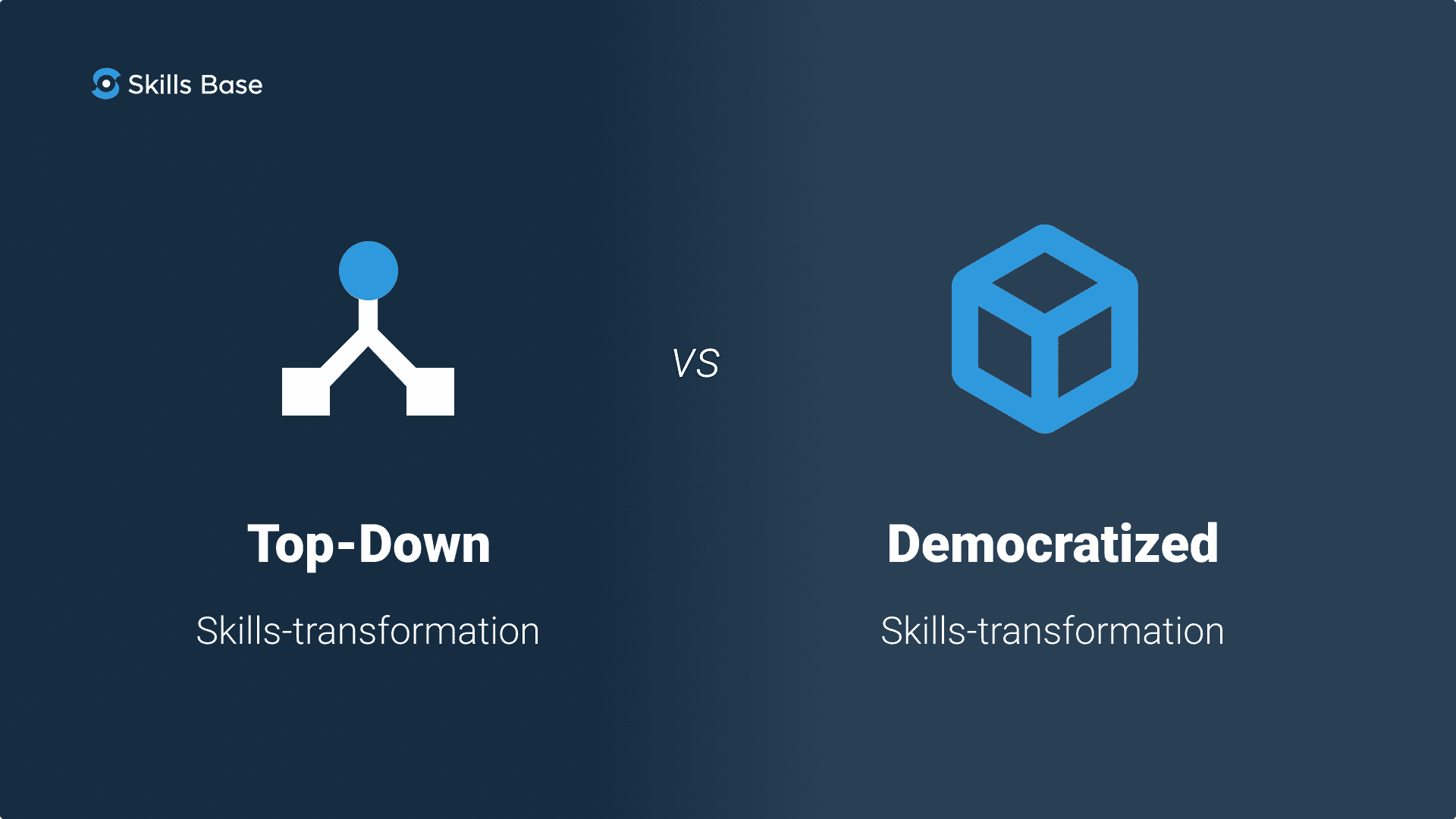In the pursuit of skills-based transformation, organizations face a crucial decision: Should they rely on a solo HR-led initiative, involve the entire organization in a democratized approach, or seek assistance from external partners? Each path has its own set of challenges and benefits, shaping the pace and effectiveness of the transformation, as well as its impact on organizational culture.
Let’s explore these options together to find the best approach for your organization’s journey towards skills development and talent management.
HR's Solo Journey: A Centralized Approach
HR departments often embark on a solo journey in skills transformation, adopting a centralized, top-down approach. They take on the monumental task of identifying skill gaps, designing training programs, and monitoring progress across the organization. This method offers consistency and alignment with broader organizational goals, but it comes with challenges such as a heavy workload for HR and potential resistance from employees who feel excluded from the decision-making process.
The Cost of Going Solo
- Heavy Workload: HR teams may find themselves overwhelmed by the scope of skills transformation initiatives.
- Limited Insight: Without involving various departments, HR might miss specific skill needs.
- Potential for Resistance: A top-down approach can lead to disengagement among employees who feel their input is undervalued.
- Having only a handful of people with the skills and knowledge to do this means you have no way of replacing them if they leave and the impact can be catastrophic as it will impact multiple teams and people. You need to have a leadership team that understands skills, skill assessments and structure.
Democratizing Progress: The Power of Collective Effort
Democratizing the process of skills transformation involves tapping into the insights and efforts of individuals throughout the organization. By involving department heads, HR gains a clearer picture of skill requirements that are aligned in a more granular way to development, tasks, and projects. This approach fosters a culture of shared responsibility and engagement, drawing on diverse perspectives.
Advantages of Collaboration
- Richer Insights: Involving a broader range of stakeholders uncovers more nuanced skill needs.
- Enhanced Engagement: Employees are more likely to support initiatives they’ve had a hand in shaping.
- Distributed Workload: Sharing the responsibility for skills transformation eases the burden on HR, enabling more focused efforts.
- A skills-based culture shouldn’t be dictated by HR. It should be driven by the entire talent pool who understand the purpose, benefits and overall shared accountability. HR provides the structure of a skills framework, and the talent pool drives the engagement and use of the skills insights.
Collaboration requires strong communication and a commitment to working together, but it offers a pathway to more sustainable and effective transformation.
The Third-Party Equation: External Expertise vs. Autonomy Loss
Another option for organizations is to engage third-party organizations. This route provides access to specialized expertise and resources not available within the organization. However, it introduces considerations around cost, time, and control. This also creates a dependency where it should instead be an internal layer of skills and capabilities.
Questions to ask yourself during Skills Transformation
Who should apply the ratings definitions for skills assessment?
HR ensures unbiased and fair assessment criteria by leveraging the expertise of departmental leaders who possess deep understanding of required skills. This collaboration enables HR to develop standards aligned to job needs and minimize biases, emphasizing the organization’s dedication to fairness.
Who should communicate the purpose of skills assessments across the organization?
Departmental leaders, in collaboration with HR, craft a communications strategy that highlights benefits for all employees. This strategy emphasizes talent development, career mobility, and the allocation of Learning and Development (L&D) budgets to bridge both current and future skills gaps.
Who should do the mapping of skills to training courses?
Departmental leaders drive this process, using skills insights to understand the financial impacts and priority ratings of each skills gap. By aligning specific L&D interventions with the identified skill gaps, they ensure targeted development opportunities. It is worth noting that Departmental leaders know their people and should engage with them to ensure L&D programs are aligned with their people preferred learning styles.
Who needs to develop the business case to justify an L&D budget using skills insights?
Departmental leaders play a crucial role in assessing the impact of skill gaps and identifying the necessary training courses. Their comprehensive understanding of skills needed at various stages within the organization’s strategic and operational plans guides the development of a solid business case that aligns skills with roles, products or services, technologies, and project teams.
The journey towards a skills-based organization requires critical decisions about leadership, implementation, and collaboration with internal and external partners.
By carefully considering the advantages and challenges of each approach—HR’s solo journey, democratizing progress, and third-party involvement—organizations can navigate their unique landscape, striking a balance that accelerates skills transformation.
The Skills Base team works with hundreds of people each month to navigate their own skills transformation projects, why not get started yourself and book in a free 30-minute meeting with our skills experts today.
